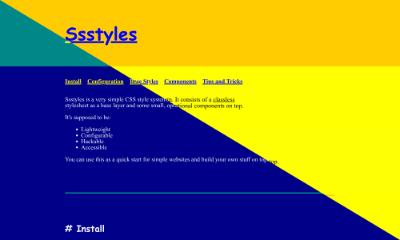
Ssstyles is a very simple CSS style system. It consists of a classless stylesheet as a base layer and some small, optional components on top.
It's supposed to be:
- Lightweight
- Configurable
- Hackable
- Accessible
You can use this as a quick start for simple websites and build your own stuff on top.
# Install
You have multiple options to install Ssstyles. I provide two packages:
- The base styles, which include a classless stylesheet for simple HTML sites
- The complete base+components package, which you can use to build more advanced sites
# CDN
Use this snippet to insert the base styles:
<link rel="stylesheet" href="https://cdn.jsdelivr.net/npm/ssstyles/dist/base.css" />Use this snippet to insert the base styles and all components:
<link rel="stylesheet" href="https://cdn.jsdelivr.net/npm/ssstyles/dist/all.css" /># npm
npm install ssstyles@layer base, layout, components;
@import "ssstyles" layer(base);
@import "ssstyles/css/transition.css" layer(base);
@import "ssstyles/css/basegrid.css" layer(layout);
@import "ssstyles/css/headline.css" layer(components);
/* Whatever components you need */
/* Or the complete package: */
@import "ssstyles/css/all.css" layer(base);# Manual installation
You can also simply download the CSS file and include it however you wish:
All file sizes are gzipped.
# Bookmarklet
You can save this link to your bookmarks and press it on any site to make it use this stylesheet: Ssstylize
# Configuration
Update the following custom properties to personalize the stylesheet:
--col-bg: <color>;
--col-bg2: <color>;
--col-bg3: <color>;
--col-fg: <color>;
--col-fg2: <color>;
--col-accent: <color>;
--col-accent2: <color>;
--col-accent-contrast: <color>;
--font-size-min: <length>;
--font-size-max: <length>;
--line-height: <number>;
--letter-spacing: <length>;
--body-width: <length>;
--border-radius: <length>;Read further configuration details
# Themes
I've added some themes, in case you don't like the default look. To apply a theme, you need to add a new layer (the themes one) and import the theme into it:
@layer base, themes, layout, components;
@import "ssstyles" layer(base);
@import "ssstyles/css/themes/business.css" layer(themes);
@import "ssstyles/css/transition.css" layer(base);
/* ... */You can also link to a theme directly in HTML:
<link rel="stylesheet" href="https://cdn.jsdelivr.net/npm/ssstyles/dist/base.css" />
<link rel="stylesheet" href="https://cdn.jsdelivr.net/npm/ssstyles/dist/themes/business.css" />Here's a list of all available themes:





# Base Styles
You can opt to use only the base package. This one uses only html tags as selectors and is meant to work with any website that hase some clean HTML right out of the box. It applies some styles to native elements, adds a basic layout and color theming. It's neither the lightest, nor the most feature complete, but it's also not too far off.
The base package also serves as the foundation to all other components.
Here are some included elements:
# Components
Here are some optional components. Most of the time, you can use them by importing the CSS file into your own styles and adding the corresponding data attribute to the element.
@import "ssstyles/css/mycomponent.css" layer(components);<div data-mycomponent></div>Here's a list of all available components:
-
Layout -
Nav -
Skiplink -
Headline -
Card -
Breakout -
Group -
Callout -
Shadow -
Toggle -
Loading -
Carousel -
Action Link -
Contact Links -
Animations
# Tips and Tricks
# Modify a component
Every component's CSS is linked on its page. Since all styles are packed into a layer, their specificity as squashed to 1. That means you can use the selector of the component and write your own styles on top.
Don't like that the sparkle animation uses the ✨-emoji?
[data-sparkle]::before,
[data-sparkle]::after {
content: "👁️";
}Why would you do that?
I have no idea. But now you can.
I would advise that you put your own modifications into a layer as well, to keep the specificity down. That'll help you keep your code organised.
# Transitions
Some components need a different transition than others - for example, combining the Card component (transition: translate) with a Shadow (transition: box-shadow). CSS would normally overwrite one transition with the other. I've added transitions to a global selector and put the transition-time in a variable that defaults to 0s.
Here is a list of all available transition variables:
--t-transform
--t-translate
--t-rotate
--t-scale
--t-box-shadow
--t-color
--t-background
--t-border-color
--t-opacity
--t-filterThat way I can enable and combine selected transitions by setting a time:
.shrink {
--t-scale: 0.5s;
&:hover {
scale: 0.8;
}
}
.fade {
--t-opacity: 0.5s;
&:hover {
opacity: 0.2;
}
}.shrink.fade
In order to get transitions working you need to import the package:
@import "ssstyles/css/transition.css" layer(base);It's already included in the full package. It's not included in the base styles, since there are not combined transitions in there.
# Custom fonts
You can include your own webfonts and set them via custom properties:
--font: "Inter";
--font-mono: "Fira Code";
--font-accent: "Lobster";Make sure you set a working fallback option and adjust for font size diffenreces to minimize CLS.
# Include Tailwind
Tailwind works great as style tokens on top of Ssstyles. You can even include Ssstyles' custom properties as Tailwind classes. Insert this into your tailwind.config.js:
module.exports = {
theme: {
extend: {
colors: {
fg: "var(--col-fg)",
fg2: "var(--col-fg2)",
bg1: "var(--col-bg1)",
bg2: "var(--col-bg2)",
bg3: "var(--col-bg3)",
accent: "var(--col-accent)",
accent2: "var(--col-accent2)",
"accent-contrast": "var(--col-accent-contrast)",
},
fontFamily: {
base: "var(--font)",
mono: "var(--font-mono)",
accent: "var(--font-accent)",
},
},
},
variants: {},
plugins: [],
};You can use it like this:
<article data-card class="bg-accent text-accent-contrast">I'm a modified card!</article>